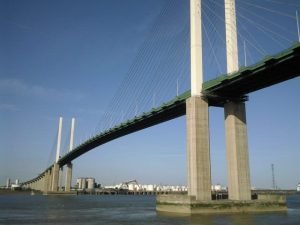Image Courtesy of geograph.org.uk
The Dartford-Thurrock crossing, also known as the Third Dartford Crossing and the Queen Elizabeth II Bridge, is the first major Build-Operate-Transfer (B.O.T.) project developed in the U.K. this century.
The crossing is the third road link over the Thames River between Kent and Essex counties, and complements the existing, two separate, north-and south-bound tunnels completed respectively in 1963 and in 1980. A third crossing was needed to off load traffic from the tunnels, particularly with forecast of increased traffic that would follow the completion of the M25 motorway. The third crossing would become an integrated part of the motorway.
In 1986, the Department of Transport made a request for proposal for the execution of the third crossing. The bid document invited contractors to propose three options, one of them being a radical shift from traditional practice in the UK; a concession to operate the two existing tunnels, and to build, finance and operate the third crossing. Seven firms presented various tunnels and bridges schemes. Trafalgar House, in consortium with its main bankers, won the contest for a four-lane bridge project. The bridge would be built in three years at a cost of £86m and the total B.O.T. scheme, including the debt of the two tunnels, would cost about £200m.
The project’s financial structure proposed by the Trafalgar House consortium was innovative. It included less than 1% of equity from Trafalgar House the rest being from financiers. It also required that Trafalgar House and its partners take the risk for construction, operation, and financing. The financiers attached significant value to the proven demand and revenue from the two existing crossing, compared to many ‘greenfield’ projects. This meant that the commercial risk was low, despite the fact that the concession company would not be allowed to increase toll rates at more than the rate of inflation. Indeed, the government was not prepared to let the concession company benefit from potential upsides, even if it was taking all of the downside risks. The treasury’s opposition to private projects and fears of discontent from the populous over high toll fees were the main reasons. The concession company was required to revert ownership of the crossings as soon as the debt was repaid, which was expected to be after 14 years of operation. (The concession had been attributed for a maximum of 20 years).
The bridge was successfully designed and built, and opened as expected in 1991. It has four lanes and doubles the capacity of the existing two tunnels. The structure consists of an 812 metre long, cable-stayed main bridge, and one kilometre long approach viaducts on both banks.
The project provides an excellent example of B.O.T. development. It shows the difficulty of pushing the ideology of private ownership for projects, such as urban transport ones, that have traditionally been the responsibility of governments because of their inherent features. The success of Dartford created a window of opportunity and served as a benchmark to develop the whole principle of Private Finance Initiative (PFI) in the UK. However, it is not a type of project structure, especially in terms of financing, that can be easily repeated. The project’s structure was feasible because there was a very low perceived risk.
